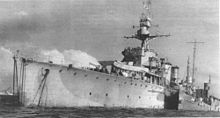
HMS Cairo (D87) was a C-class light cruiser of the Royal Navy, named after the Egyptian capital, Cairo. So far she has been the only ship of the Royal Navy to bear the name. She was part of the Carlisle group of the C-class of cruisers.
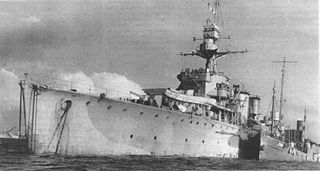
HMS Dragon, also known in Polish service as ORP Dragon, was a D- or Danae-class cruiser built for the Royal Navy. She was launched in Glasgow, in December 1917, and scuttled in July 1944 off the Normandy beaches as part of the Arromanches Breakwater.

HMS Galatea was one of eight Arethusa-class light cruisers built for the Royal Navy in the 1910s. She fought in the First World War, participating in the Battle of Jutland. Following the war, she was scrapped.
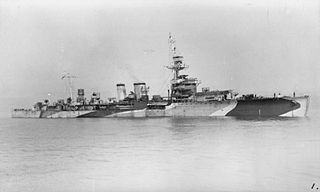
HMS Danae was the lead ship of the Danae-class cruisers, serving with the Royal Navy between the world wars and with the Polish Navy during the latter part of World War II as ORP Conrad.

HMS Diomede was a Danae-class cruiser of the Royal Navy. Constructed at Vickers Armstrong, Barrow, she was constructed too late to take part in World War I and was completed at the Royal Dockyard, Portsmouth. Between the wars, she served on the China Station, Pacific waters, East Indies Waters and from 1936 onwards, in reserve. In World War II she performed four years of arduous war duty, during which time she captured the crew of the German blockade runner Idarwald after she had chased that ship and when the crew scuttled Idarwald. Between 22 July 1942 and 24 September 1943 she was converted to a training ship at Rosyth Dockyard. In 1945 she was placed in reserve and scrapped a year later.

HMS Dunedin was a Danae-class light cruiser of the Royal Navy, pennant number D93. She was launched from the yards of Armstrong Whitworth, Newcastle-on-Tyne on 19 November 1918 and commissioned on 13 September 1919. She has been the only ship of the Royal Navy to bear the name Dunedin.

HMS Delhi was a Danae-class cruiser that served with the Royal Navy through the Second World War, from the Caribbean to eastern China. She was laid down in 1917, launched in 1918 and commissioned for service in 1919, serving until decommissioning in mid-1945 due to extensive battle damage, and was to be scrapped in 1948 after lengthy war and peacetime service around the world.

HMS Coventry was a C-class light cruiser of the Royal Navy, named after the English city of Coventry. She was part of the Ceres group of the C-class of cruisers.

HMS Colombo was a C-class light cruiser built for the Royal Navy during World War I. She was part of the Carlisle sub-class of the C class. She survived both world wars to be scrapped in 1948.
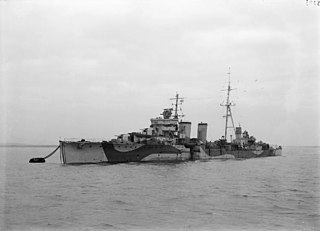
HMS Caledon was a C-class light cruiser built for the Royal Navy during World War I. She was the name ship of the Caledon sub-class of the C class. She survived both world wars to be scrapped in 1948.

HMS Cambrian was a C-class light cruiser built for the Royal Navy during World War I. She was the name ship of her sub-class of four ships. Assigned to the Grand Fleet upon completion in 1916, the ship played only a small role during the war. Cambrian was assigned to the Atlantic and Mediterranean Fleets during the 1920s and was sent to support British interests in Turkey during the Chanak Crisis of 1922–1923. The ship was placed in reserve in late 1929. She was sold for scrap in 1934.

HMS Conquest was a C-class light cruiser of the Royal Navy that saw service during World War I. She was part of the Caroline group of the C class.

HMS Inconstant was one of eight Arethusa-class light cruisers built for the Royal Navy in the 1910s. She fought in the First World War, participating in the Battle of Jutland. Following the war, she was scrapped.

HMS Phaeton was one of eight Arethusa-class light cruisers built for the Royal Navy in the 1910s. She fought in the First World War, participating in the Battle of Jutland. Following the war, she was scrapped.
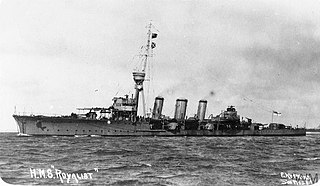
HMS Royalist was one of eight Arethusa-class light cruisers built for the Royal Navy in the 1910s. She fought in the First World War, participating in the Battle of Jutland. Following the war, she was scrapped.

HMS Penelope was one of eight Arethusa-class light cruisers built for the Royal Navy in the 1910s. She fought in the First World War, following the war, she was scrapped.

HMS Undaunted was one of eight Arethusa-class light cruisers built for the Royal Navy in the 1910s.

HMS Dauntless was a Danae-class light cruiser of the Royal Navy. She was built by Palmers Shipbuilding and Iron Company of Jarrow, launched on 10 April 1918 and commissioned on 22 November 1918.

HMS Despatch was a Danae-class light cruiser built for the Royal Navy during World War I. She was part of the Delhi sub-class of the Danae class.

HMS Durban was a Danae-class light cruiser of the Royal Navy. She was launched from the yards of Scotts Shipbuilding and Engineering Company on 29 May 1919 and commissioned on 1 November 1921.


